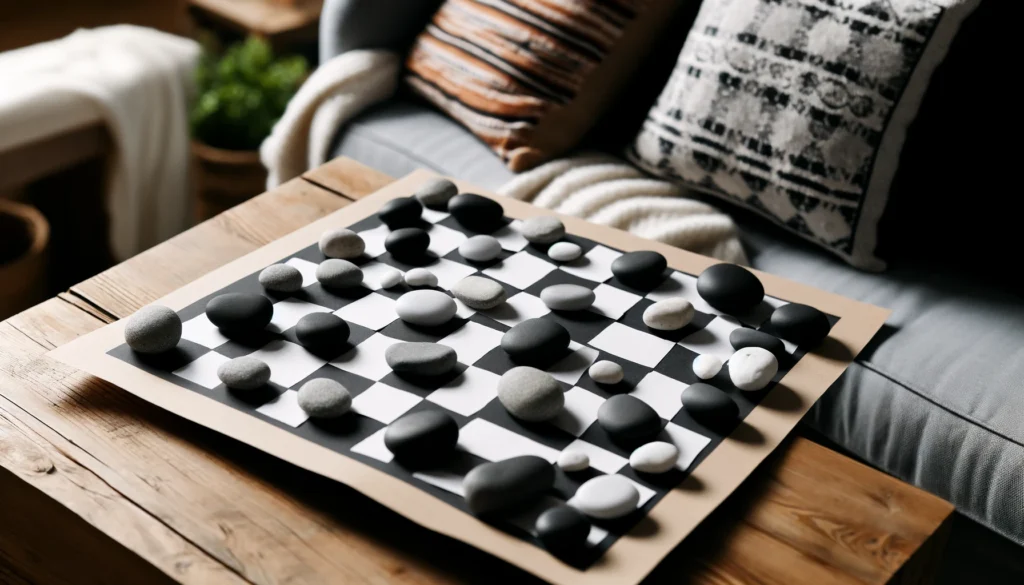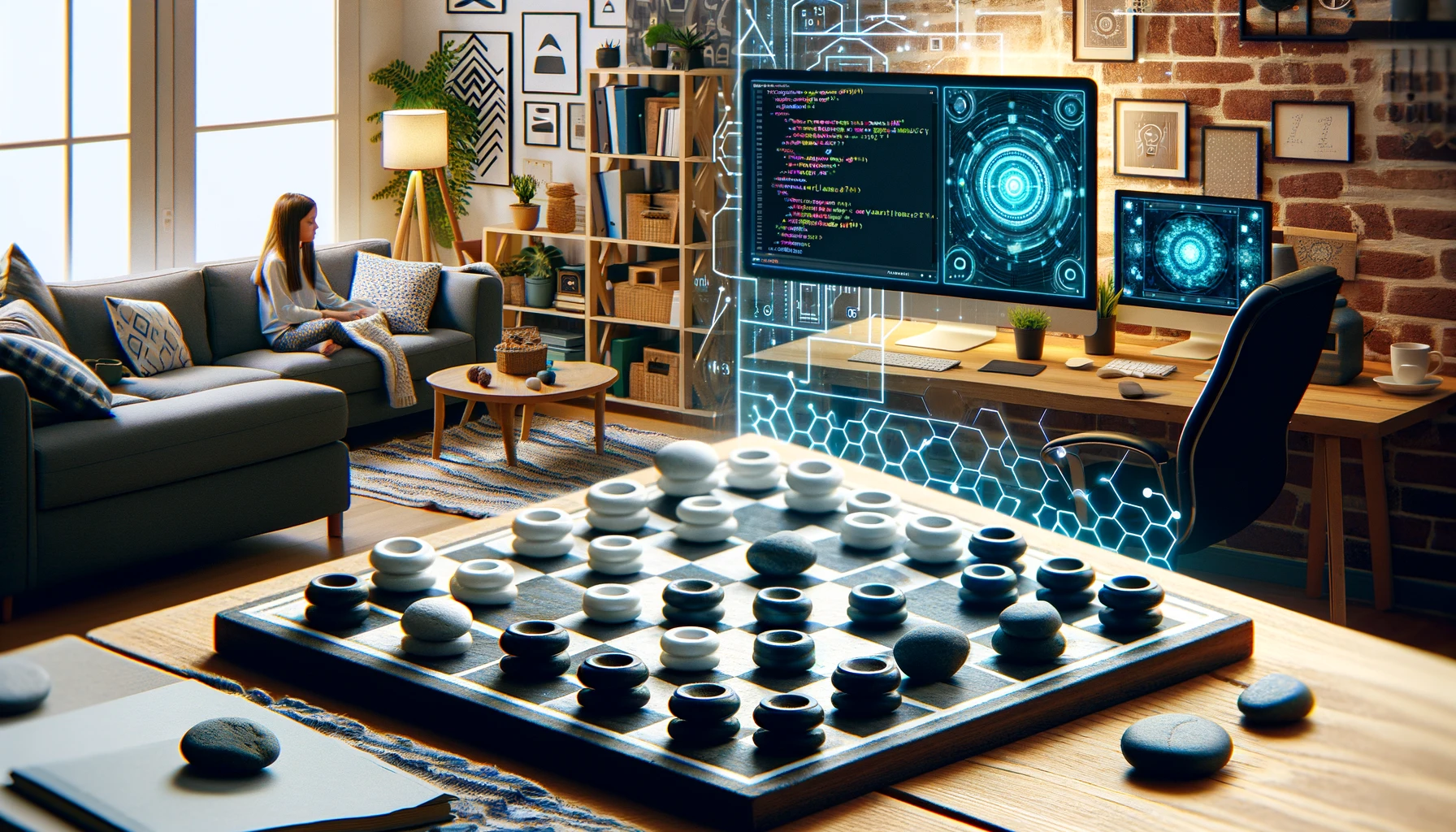Hey there!
Have you ever tried to turn something ordinary into something extraordinary with a bit of creativity and tech? That’s precisely what I’ve been up to lately. My kids and I have found joy in playing checkers for the past few months. Not with a fancy board but with a sheet of colored paper and rocks we collected during our walks. It’s simple, but it’s ours and filled with memories.

But why stop there? I decided to take this simple checkerboard and bring it into the digital world using ReactJS. This project isn’t just about coding; it’s about connecting with my children through my work and showing them the magic of turning ideas into reality. So, let me take you through this journey of creating a digital checkers game and maybe inspire you to think about how you can blend your passions and profession in a fun and engaging way.
Personal Motivation: From Paper to Pixels
The idea started during one of our regular family game nights. While arranging our makeshift checkers set, it hit me: what if I could make this game come alive on a screen? More than just a game, it could be a learning tool for my kids to see what dad does and maybe spark their interest in technology.

Building this game digitally was about creating something that could last, something interactive and educational. I wanted to build an app that entertains and educates them, showing them the ropes of logical thinking and problem-solving in a format they love.
Building the Checkers Game
Setting Up the React Environment
Alright, let’s kick things off by setting up our digital canvas. We will use Create React App, like getting a ready-made kit to start painting our masterpiece. If you’re new to this, it’s a great way to jump right in without getting bogged down by setup details. It’s as simple as running a couple of commands on your terminal, and voilà, you’re ready to start coding.
Designing the Game Components
Now, let’s break down our game into its core components. It’s like putting together a team where everyone has a special role to play:
- Board: This is the heart of our game, the grid where all the action happens. The Board is responsible for displaying all the squares and pieces.
- Square: Think of each square as a tiny stage for our pieces. The squares need to know if they’re occupied and who’s standing on them—a regular piece or a king.
- Piece: These are the stars of our show. Each piece can either move forward or jump over an opponent to capture them, depending on whether it’s a king. They’re quite the performers!
- GameControl: This isn’t just about keeping score. It’s like the director of our play telling us whose turn it is and announcing the winner. It keeps the game organized and flowing smoothly.
Implementing the Custom Hook: useBoard
To keep all these components working together seamlessly, I decided to create a custom hook called useBoard. This little piece of code magic is used useState to manage the entire state of the game. Here’s how it works:
- useState: We use this to hold our game’s state, which includes the positions of all the pieces on the board. Every time a piece moves or a capture is made, useState updates our state to reflect these changes.
This hook acts as our command center, handling updates and ensuring that every component reflects the game’s current state. It’s like having an air traffic controller who ensures everything runs smoothly and everyone knows where they need to be.
Adding the GitHub Repository
As we dive into the nuts and bolts of coding, I want to ensure you have all the resources at your fingertips. That’s why I’ve compiled all the code and documentation on my GitHub repository. Whether you’re a seasoned developer or just starting out, you’ll find the repository packed with insights and ready-to-use code that you can tweak and explore. Check it out here, and feel free to fork it, star it, or contribute. This project is about learning and growing together, and your input can help make this game even better!
The Evolving Role of Developers: Embracing AI and Iterative Strategies
In the rapidly changing world of software development, the role of a developer is much more than just writing code; it’s about being a visionary and a problem solver. As we build applications and systems, we’re constantly challenged to innovate and adapt to new technologies that can enhance our work and creativity. My journey with creating a digital checkers game is a perfect example of this modern approach.
Partnering with AI
I partnered with artificial intelligence to refine and test the game components and logic for this project. AI has been an incredible co-creator, helping to simulate countless game scenarios to ensure the rules are applied correctly and the game plays smoothly. This collaboration allowed me to tweak and improve the game iteratively, making adjustments based on AI-generated feedback. This is not just about automating tasks but about leveraging AI to enhance the creative process, bringing more sophistication and accuracy to the development.

Iterative Development Strategy
The essence of my approach was to build the checkers game one step at a time—an iterative strategy that is increasingly common in today’s software development practices. Starting with the basic components—Board, Square, Piece, and GameControl—I developed each piece individually, testing and integrating them as I progressed. This method allowed for easier troubleshooting and debugging and made it possible to refine each component without disrupting the entire system.
By iterating, I could adapt quickly to any challenges that arose, applying fixes and enhancements on the fly. This agile approach aligns perfectly with the dynamic nature of technology, where being flexible and responsive to change is key.
The Impact of New Technologies
The integration of AI and the use of an iterative strategy reflect how new technologies are transforming the role of developers. We are no longer just coders but architects and strategists, using technology to solve complex problems and create innovative solutions. These tools allow us to focus more on design and user experience, pushing the boundaries of what we can achieve and allowing more room for creativity.
Looking Ahead
As technology continues to evolve, so too must we. By embracing AI, iterative development, and other emerging technologies, developers can improve their current projects and pave the way for future innovations. It’s an exciting time to be in this field. I encourage all developers to explore these technologies, experiment with new approaches, and continue pushing the possible limits.
The Future: Integrating AI
I plan to take this project a step further by introducing an AI component. Imagine playing against a computer that can challenge and adapt to your skill level. I’ll be working on this feature soon, and I encourage you to think about how AI could enhance your projects, too.
What started as a simple family game turned into a project that bridges my professional life and personal passions. I hope this inspires you to look at the things you love through the lens of what you do and find new ways to merge the two.
So, what are you waiting for? Mix something you love with technology, and see what you can create. And if you do, I’d love to hear about it!


Leave a Reply